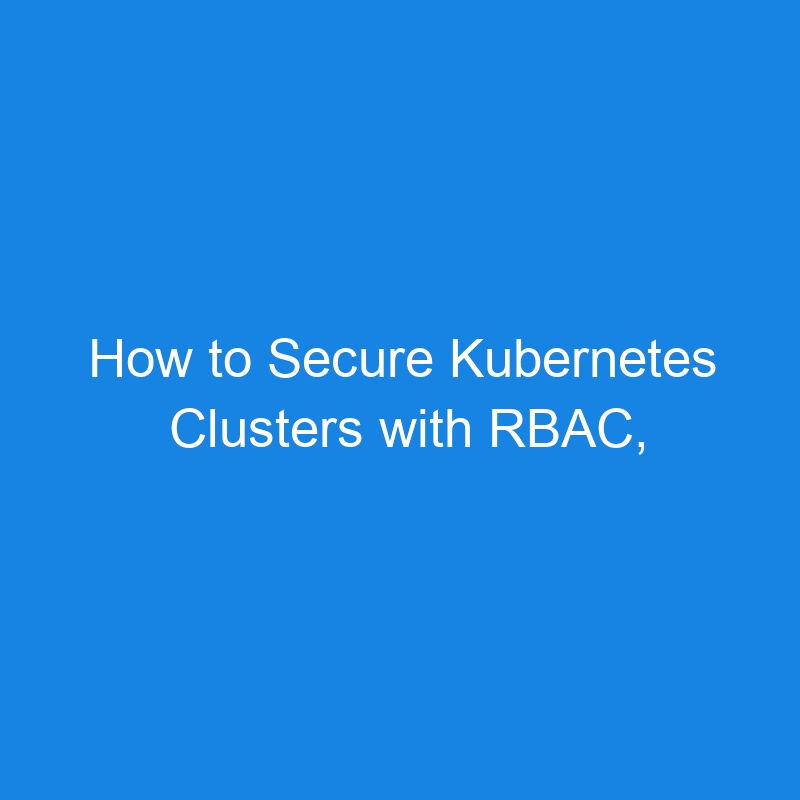How to Secure Kubernetes Clusters with RBAC, Network Policies, and Encryption
Securing Kubernetes clusters is critical to protect your applications, data, and infrastructure. Kubernetes offers a variety of built-in security mechanisms, including Role-Based Access Control (RBAC), Network Policies, and Encryption. Each of these tools addresses specific security aspects of the cluster, ensuring a layered approach to security.
This article explains how to implement these mechanisms effectively in Kubernetes clusters.
1. Role-Based Access Control (RBAC)
RBAC controls access to Kubernetes resources based on roles and the permissions assigned to them. It uses the principle of least privilege, ensuring that users and applications only have the permissions they need to function.
Key RBAC Components
- Roles and ClusterRoles: Define permissions at the namespace level (Role) or cluster-wide (ClusterRole).
- RoleBindings and ClusterRoleBindings: Assign roles to users, groups, or service accounts.
Implementing RBAC
-
Create a Role:
ARolegrants access to specific resources in a namespace. Example:
apiVersion: rbac.authorization.k8s.io/v1
kind: Role
metadata:
namespace: default
name: pod-reader
rules:
- apiGroups: [""]
resources: ["pods"]
verbs: ["get", "watch", "list"]
-
Create a RoleBinding:
ARoleBindingassociates a role with a user, group, or service account.
apiVersion: rbac.authorization.k8s.io/v1
kind: RoleBinding
metadata:
name: read-pods
namespace: default
subjects:
- kind: User
name: jane
apiGroup: rbac.authorization.k8s.io
roleRef:
kind: Role
name: pod-reader
apiGroup: rbac.authorization.k8s.io
-
Use ClusterRole and ClusterRoleBinding:
For cluster-wide access, useClusterRoleandClusterRoleBinding. Example:
apiVersion: rbac.authorization.k8s.io/v1
kind: ClusterRole
metadata:
name: node-reader
rules:
- apiGroups: [""]
resources: ["nodes"]
verbs: ["get", "list"]
apiVersion: rbac.authorization.k8s.io/v1
kind: ClusterRoleBinding
metadata:
name: read-nodes
subjects:
- kind: User
name: john
apiGroup: rbac.authorization.k8s.io
roleRef:
kind: ClusterRole
name: node-reader
apiGroup: rbac.authorization.k8s.io
2. Network Policies
Network Policies are used to control communication between Pods and other network endpoints in the cluster. They define rules for ingress (incoming) and egress (outgoing) traffic at the Pod level.
Key Features
- Allow or deny traffic to/from Pods based on labels.
- Restrict communication within the cluster and from external sources.
Implementing Network Policies
-
Enable a Network Policy Provider:
Network Policies require a CNI (Container Network Interface) plugin that supports them, such as Calico, Cilium, or Weave Net. -
Create a Network Policy:
Example: Allow traffic only from Pods with a specific label.
apiVersion: networking.k8s.io/v1
kind: NetworkPolicy
metadata:
name: allow-app-traffic
namespace: default
spec:
podSelector:
matchLabels:
app: my-app
ingress:
- from:
- podSelector:
matchLabels:
app: another-app
ports:
- protocol: TCP
port: 80
-
Restrict All Traffic by Default:
Define a “deny-all” policy for Pods to ensure no traffic is allowed unless explicitly permitted.
apiVersion: networking.k8s.io/v1
kind: NetworkPolicy
metadata:
name: deny-all
namespace: default
spec:
podSelector: {}
ingress: []
egress: []
3. Encryption
Encryption protects sensitive data at rest and in transit, ensuring confidentiality and integrity.
Encrypting Data at Rest
Kubernetes allows you to encrypt sensitive resources like Secrets using encryption providers.
-
Enable Encryption for Secrets:
Configure thekube-apiserverto use an encryption configuration file.
Example encryption configuration:
apiVersion: apiserver.config.k8s.io/v1
kind: EncryptionConfiguration
resources:
- resources:
- secrets
providers:
- aescbc:
keys:
- name: key1
secret: <base64-encoded-secret-key>
- identity: {}
Start the API server with the --encryption-provider-config flag:
kube-apiserver --encryption-provider-config=/path/to/encryption-config.yaml
-
Rotate Encryption Keys:
Regularly rotate encryption keys to enhance security. Use thekube-apiserverto re-encrypt data with a new key.
Encrypting Data in Transit
Secure communication between Kubernetes components and external clients using TLS (Transport Layer Security).
-
Enable HTTPS for API Server Communication:
Use certificates to secure communication with the Kubernetes API server. Provide--tls-cert-fileand--tls-private-key-fileflags. -
Use Mutual TLS (mTLS):
Configure mutual TLS to authenticate and encrypt communication between cluster components, such as the API server, kubelet, and etcd. -
Secure etcd Communication:
Enable TLS encryption for the etcd database, which stores cluster state data. Example:
etcd --cert-file=/etc/etcd/etcd.pem
--key-file=/etc/etcd/etcd-key.pem
--peer-cert-file=/etc/etcd/peer-etcd.pem
--peer-key-file=/etc/etcd/peer-etcd-key.pem
Best Practices for Securing Kubernetes Clusters
-
Principle of Least Privilege (RBAC):
- Use granular roles and bindings to limit access to only what is necessary.
- Avoid using the default namespace for critical resources.
-
Enforce Network Segmentation:
- Use Network Policies to isolate sensitive applications.
- Limit ingress and egress traffic by default.
-
Encrypt Sensitive Data:
- Always encrypt Secrets and other sensitive resources at rest.
- Use strong TLS certificates for securing data in transit.
-
Audit and Monitor:
- Enable Kubernetes auditing to track API requests.
- Use tools like Falco, Prometheus, or Grafana to monitor cluster activity.
-
Regularly Update and Patch:
- Keep Kubernetes components and the underlying OS up to date to mitigate vulnerabilities.
Conclusion
By combining RBAC for access control, Network Policies for traffic management, and Encryption for securing data, you can significantly enhance the security of your Kubernetes clusters. Adopting a defense-in-depth approach ensures that your applications and data remain protected, even if one layer is compromised.
